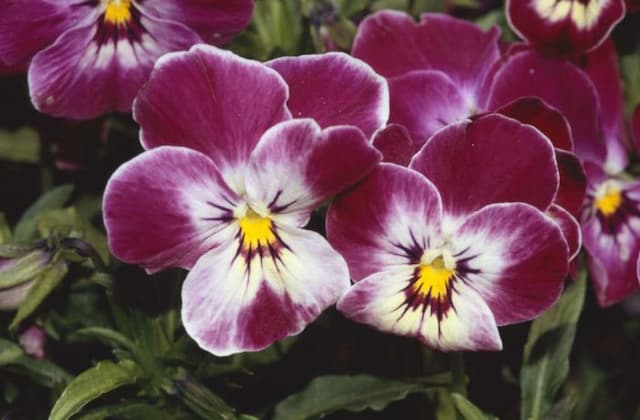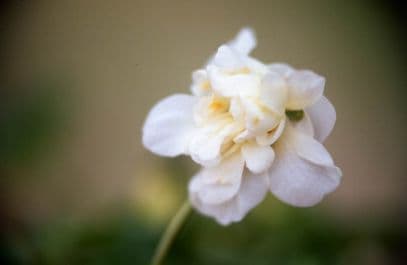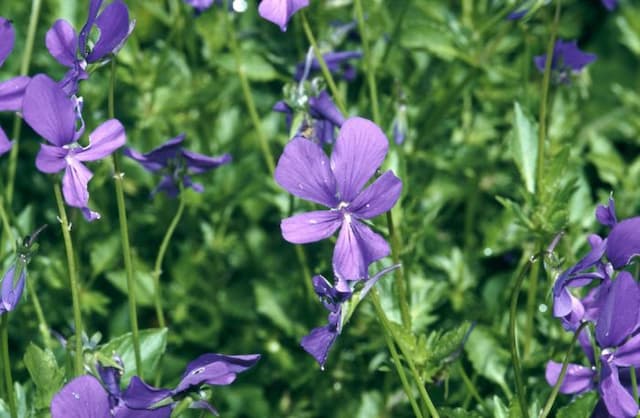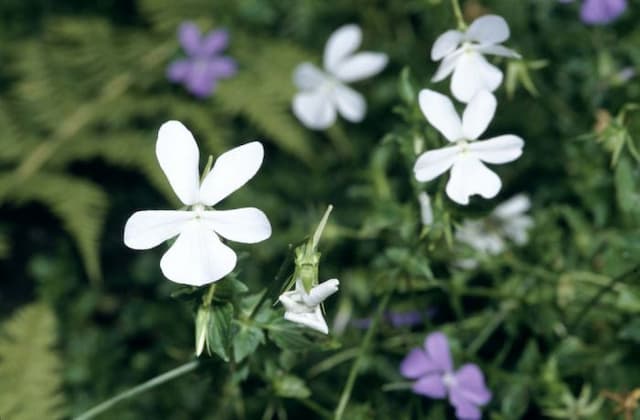Pansy Viola 'D'Udine' (dPVt)

ABOUT
Viola 'D'Udine' is a variety of the common pansy that is admired for its charming and distinctive flowers. The plant bears a profusion of blossoms that display a remarkable range of colors, often featuring a mix of purples, blues, yellows, and whites. The petals are velvety and soft, radiating outwards in a classic pansy form, which typically shows a pattern resembling a face in the center. The central portion of each flower, known as the "blotch" or "face," is usually a darker color, creating a beautiful contrast with the lighter edges of the petals. This pattern serves to attract pollinators to the center of the flower where the reproductive organs are located. Additionally, these flowers have a delicate, subtle fragrance that adds to their overall allure. The foliage of Viola 'D'Udine' consists of compact, green, heart-shaped leaves that provide a lush backdrop for the vibrant blooms. The plant has a bushy habit, forming a mound that is densely packed with these attractive leaves, from which the stems of the flowers emerge. Overall, Viola 'D'Udine' is a delightful plant that brings a splash of color and elegance to any garden space.
About this plant
 Names
NamesFamily
Violaceae
Synonyms
Udine Violet
Common names
Viola 'D'Udine' (dPVt)
 Toxicity
ToxicityTo humans
Violas, commonly known as pansies or violets, are not generally considered toxic to humans. Most species are safe to handle and some are even edible, often used as garnishes or in salads. However, it's important to note that sensitivity to plants can vary among individuals and consuming plants that have been treated with pesticides or other chemicals can be harmful. If any part of the viola plant is ingested in large quantities, it may cause mild gastrointestinal distress, but such instances are rare.
To pets
Pansies are typically not toxic to pets. These flowers are often considered safe for dogs, cats, and other animals. If a pet ingests part of a pansy plant, it is unlikely to cause any significant harmful effects. However, overconsumption might result in mild gastrointestinal upset in some pets. As with any non-food plant, it's always best to monitor your pets and prevent them from eating large amounts of foliage, as individual pets may have sensitivities or allergies.
 Characteristics
CharacteristicsLife cycle
Perennials
Foliage type
Deciduous
Color of leaves
Green
Flower color
Varies
Height
0.5 feet (15 cm)
Spread
1 feet (30 cm)
Plant type
Herb
Hardiness zones
Varies
Native area
Europe
Benefits
 General Benefits
General Benefits- Ornamental value: Viola 'D'Udine', commonly known as pansy, is highly valued for its decorative flowers that enhance the aesthetics of gardens and landscapes.
- Seasonal color: Pansies provide vibrant color in the spring and fall when many other plants are not in peak bloom.
- Cold tolerance: Pansies are capable of withstanding cooler temperatures, making them suitable for early spring and late fall planting in temperate climates.
- Versatility: They can be planted in flower beds, borders, containers, and hanging baskets, providing flexibility in garden design.
- Ease of care: Pansies are generally low-maintenance, requiring minimal care beyond regular watering and occasional fertilization.
- Attracts pollinators: The flowers attract butterflies and other beneficial pollinators, supporting biodiversity in the garden.
- Edible flowers: Pansy flowers are edible and can be used in salads, as garnishes, or in other culinary applications, adding a unique flair to dishes.
- Rapid growth: Pansies tend to grow quickly, allowing for a swift display of flowers after planting.
- Wide range of colors: They come in a variety of colors and patterns, offering numerous choices for garden themes and color schemes.
- Propagation: Pansies can be propagated easily from seed, making it simple for gardeners to grow new plants each season.
 Medical Properties
Medical PropertiesThis plant is not used for medical purposes.
 Air-purifying Qualities
Air-purifying QualitiesThis plant is not specifically known for air purifying qualities.
 Other Uses
Other Uses- The Viola 'D'Udine' can be used as a natural dye source, imparting gentle shades of green or yellow depending on the mordant used.
- The flowers of the plant can be crystalized with egg white and sugar to create decorative edible garnishes for desserts.
- Petals of the Viola 'D'Udine' can be used in crafts, such as pressed flower art, due to their vibrant colors and flat faces that press well.
- The leaves and flowers of the Viola 'D'Udine' can be infused in water to create scented rinses for hair, thought to impart a gentle fragrance.
- The viola can be used in potpourri mixes for its delicate scent and the aesthetic appeal of its dried petals.
- Viola 'D'Udine' petals can be incorporated into paper making processes to create paper with decorative floral inclusions.
- These flowers can be used in the culinary field as a natural coloring agent to give a subtle hue to sugars, syrups, and icings.
- Viola 'D'Udine' can be tossed into salads, not only as an ornamental addition but also to add a mild and slightly sweet flavor.
- The petals can be frozen in ice cubes to create visually stunning additions to cold beverages, particularly in the spring and summer.
- These plants can be used in educational settings, such as schools, to teach children about plant biology and the lifecycle of flowers through direct observation and care.
Interesting Facts
 Feng Shui
Feng ShuiThe pansy is not used in Feng Shui practice.
 Zodiac Sign Compitability
Zodiac Sign CompitabilityThe pansy is not used in astrology practice.
 Plant Symbolism
Plant Symbolism- Love: Violas are often symbolic of love and affection, making "Viola 'D'Udine'" a potential symbol for romantic sentiment.
- Remembrance: In Victorian symbolism, violas were associated with remembrance and contemplative thoughts, suggesting that Viola 'D'Udine' could be used to remember a loved one or a cherished memory.
- Innocence: The delicate nature of violas can represent innocence and purity, potentially reflecting the untainted quality or youthful innocence in Viola 'D'Udine'.
- Healing: Some cultures believe violas have healing properties, making Viola 'D'Udine' potentially symbolic of healing and recovery.
 Water
WaterPansies, including the Viola 'D'Udine', require consistent moisture for optimal growth, but they don’t like to be overly soggy. Ideally, watering should be done when the top inch of soil feels dry to the touch. You can water the plant thoroughly, allowing the water to penetrate deeply into the soil, which encourages deeper root growth. Depending on the climate and weather conditions, this might translate to watering once every week with about a gallon of water for outdoor plants, or more often for potted specimens in warmer, drier conditions. Ensure that the plant has good drainage to prevent root rot.
 Light
LightPansies, such as the Viola 'D'Udine', thrive in a location where they can receive full to partial sunlight. The ideal spot would be one that gets at least 6 hours of direct sunlight per day. However, in very hot climates, they benefit from some afternoon shade to protect them from the intense heat.
 Temperature
TemperaturePansies, including the Viola 'D'Udine', prefer cooler temperatures and will thrive when the temperature ranges between 40°F and 60°F. They can withstand frosts and short periods of temperatures down to about 20°F, but extended exposure to heat above 80°F can be detrimental. The ideal growing conditions for pansies include cool nights and moderate daytime temperatures.
 Pruning
PruningPansies, like Viola 'D'Udine', benefit from regular deadheading to remove faded flowers, which encourages the plant to produce more blooms. Additionally, light pruning can help maintain a bushy, compact shape and promote healthier growth. Pruning is best done in the early spring or fall.
 Cleaning
CleaningAs needed
 Soil
SoilPansies prefer well-draining, fertile soil with a pH between 5.4 and 5.8. A mix of peat, compost, and perlite or vermiculite is ideal. Regular feeding can enhance flowering.
 Repotting
RepottingPansies, including Viola 'D'Udine', typically don't need frequent repotting. They should be repotted when they outgrow their current container or every 1-2 years.
 Humidity & Misting
Humidity & MistingPansies favor moderate humidity levels. They thrive best when the relative humidity is between 40% and 60%.
 Suitable locations
Suitable locationsIndoor
Place in bright, indirect light and ensure good air circulation.
Outdoor
Plant in partial shade, ensure well-draining soil.
Hardiness zone
6-9 USDA
 Life cycle
Life cycleThe viola 'D'Udine', a variety of pansy, begins its life cycle when seeds are sown in warm soil, typically in spring or summer. The seeds germinate, and seedlings emerge, developing a root system and the first true leaves. As the plant grows, it develops a rosette of leaves and then stems that bear the distinctive flowers, which can come in a range of colors and often have a face-like pattern. After pollination by insects or self-pollination, seeds are produced in small capsules, which when mature, open to release seeds for the next generation. The viola 'D'Udine' is usually grown as an annual or biennial, meaning it completes its life cycle in one or two growing seasons, respectively, although it can occasionally survive as a perennial in favorable conditions. The plant goes dormant or dies after seed production, having completed its life cycle, and relies on the new seeds to propagate the next generation of pansies.
 Propogation
PropogationPropogation time
Spring-Early Summer
Propogation: Viola 'D'Udine', commonly known as a type of Violet, is most popularly propagated through division, which is ideally performed in the spring or autumn. To propagate by division, carefully dig up the parent plant, ensuring you lift the entire root ball. Gently tease apart the plant clumps into smaller sections, making sure each new section has a good amount of roots attached. Replant the divided sections at the same depth they were originally growing, spacing them about 6 to 12 inches (approximately 15 to 30 centimeters) apart to allow for adequate growth. Water the newly planted divisions thoroughly to help establish them in their new locations. This method is efficient and maintains the genetic integrity of the parent plant, making it a preferred choice among gardeners.









